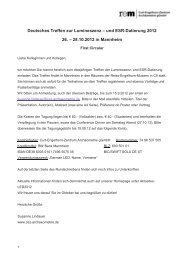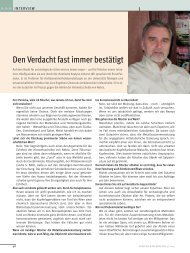Jahresbericht 2010 - Curt-Engelhorn-Zentrum Archäometrie gGmbH
Jahresbericht 2010 - Curt-Engelhorn-Zentrum Archäometrie gGmbH
Jahresbericht 2010 - Curt-Engelhorn-Zentrum Archäometrie gGmbH
Erfolgreiche ePaper selbst erstellen
Machen Sie aus Ihren PDF Publikationen ein blätterbares Flipbook mit unserer einzigartigen Google optimierten e-Paper Software.
Seite 40 <strong>Jahresbericht</strong> <strong>2010</strong><br />
Metallographic and mineralogical<br />
results demonstrate<br />
the occurrence of<br />
both oxides (Figure 3a-3b,<br />
previous page) and sulphides<br />
(Figure 4a-4b) in<br />
the samples.<br />
Finally, lead isotope analysis<br />
will be used to characterise<br />
potential ore<br />
sources in northern Chile.<br />
Öur future research plans<br />
include investigation of<br />
the contexts of metal production<br />
in the area. The<br />
Fig. 4 a Fragment of copper-tin alloy from the San Pedro<br />
de Atacama region (Middle-Intermediate Period, A.D. 990-<br />
1030). Magnif. 200x<br />
Introduction<br />
Out of the total of thirteen<br />
cave sites found on the entire<br />
eastern Adriatic coast<br />
and hinterland from the<br />
Late Glacial period, Vela<br />
Spila on Korc ula, Vlakno on<br />
Dugi otok, Zemunica in Dalmatinska<br />
Zagora and<br />
Kopac ina on Brac , were<br />
discovered in Dalmatia<br />
(Figure 1).<br />
First explorations of the<br />
Kopac ina cave were carried<br />
recovery and characterisation<br />
of production-related<br />
materials such as slag and<br />
other metallurgical byproducts<br />
will enable us to<br />
reconstruct the technological<br />
processes involved in<br />
the extraction of metal<br />
from ore. Geochemical<br />
analysis will allow us to<br />
explore the all-important<br />
relationship between various<br />
local ore sources and<br />
archaeological slags and<br />
furnace sites, and between<br />
the copper produced at the<br />
out in 1891 by F. Bulic and<br />
J. Szombathy. This report<br />
represents a results summary<br />
of the quantitative<br />
analysis of lithic assemblage<br />
discovered during<br />
excavations in the Kopač<br />
ina čave (Figüre 2) led by<br />
B. C ec uk from 1978 to<br />
1993 (C ec uk 1996) and the<br />
integral article is in print<br />
(Vuko-savljević et al. 2011).<br />
The laboratory part of the<br />
petroarchaeological analy-<br />
identified sites and the metal<br />
artefacts from the Atacama<br />
region. Önce the primary<br />
production forms and<br />
contexts have been established,<br />
efforts will be made<br />
to trace any changes in the<br />
technology or choice of raw<br />
materials. Because technology<br />
is entwined with cultural<br />
dynamics, the study will<br />
seek to reconstruct the social<br />
and economic processes<br />
of which this industry<br />
was a part.<br />
Fig. 4 b The same sample as above, but seen under polarised<br />
light. The dark coloration of the inclusions categorises<br />
them as sulphides.<br />
Late Glacial chipped stone industry from the Kopačina cave (Dalmatia,<br />
Croatia)<br />
Zlatko Perhoč, Nikola Vukosavljević<br />
sis of lithic assemblage was<br />
performed at the <strong>Curt</strong>-<br />
<strong>Engelhorn</strong>-<strong>Zentrum</strong><br />
Archa ometrie in Mannheim,<br />
which started as part of the<br />
study on raw material procurement<br />
in prehistoric<br />
lithic industries in Middle<br />
Dalmatia (Perhoč 2009a;<br />
Č eč ük 1996).<br />
The purpose of petroarchaeological<br />
analysis is to<br />
indicate the likely origin of<br />
stones used to make Kopa-




